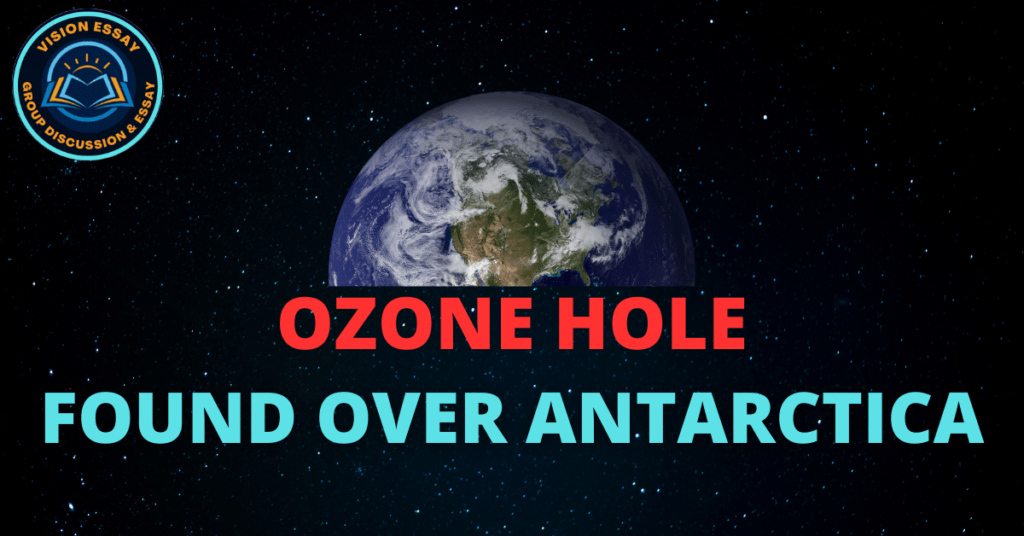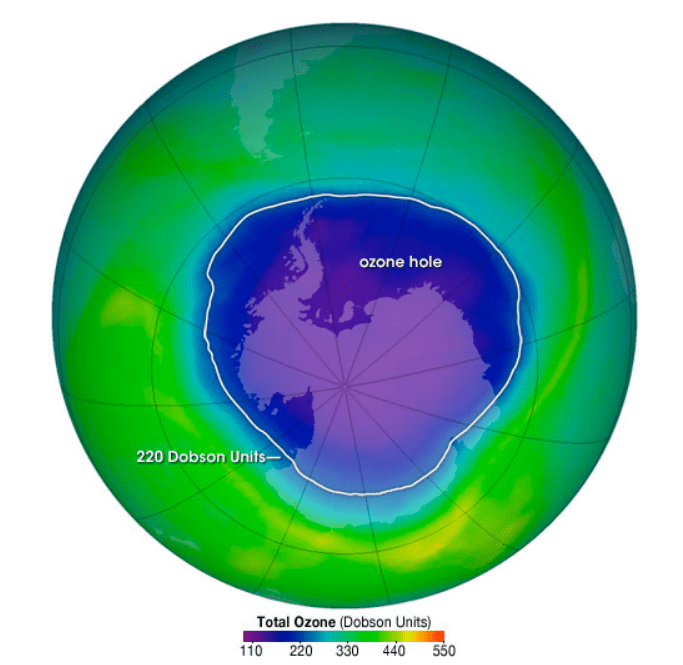
Introduction
Concerns have been raised when satellite readings over Antarctica indicated a significant “ozone-depleted area,” or ozone hole. This noteworthy anomaly was photographed by the Copernicus Sentinel-5P satellite of the European Space Agency.
What is an Ozone Hole?
- The ozone hole is an area in the stratosphere of Earth, particularly over Antarctica, where the concentration of ozone (O3) molecules is considerably reduced. Chlorofluorocarbons (CFCs), which are synthetic chemicals, are to blame for this depletion because as they decompose, they emit chlorine atoms.
- The ozone layer thins as a result of the chlorine atoms’ catalyzation of ozone breakdown. This gap enables dangerous ultraviolet (UV) light from the sun to enter Earth’s atmosphere, raising the risk of skin cancer, eye injury, and environmental devastation.
- International initiatives, like the Montreal Protocol, have been successful in lowering CFC emissions, reducing ozone depletion, and allowing the ozone layer to gradually recover.
- Technically, there is no ozone in the ozone hole, hence it is not a “hole.” The region where ozone concentrations fall below the historical cutoff of 220 Dobson Units is referred to as the “hole” by scientists.

What is the Mechanism Behind Ozone Hole?
- The rotation of the Earth causes certain winds to blow across Antarctica’s confined landmass, which leads to the opening of the ozone hole.
- The dynamics of the ozone hole are greatly influenced by the polar vortex, a band of powerful winds that round the poles.
- Temperature differences cause polar vortices to develop throughout the winter and serve as a barrier to shield arctic air from warmer lower-latitude air.
- Polar stratospheric clouds (PSCs) are cooled by this isolation, which leads to ozone-depleting processes.
- Chlorine and bromine chemicals are activated as a result of chemical processes that take place on PSC surfaces. These substances, notably chlorine, operate as catalysts in processes that deplete the ozone layer. They cause ozone molecules to disintegrate when exposed to sunshine.
- Ozone depletion is directly impacted by the polar vortex’s size and strength. The ozone hole eventually closes when it decreases in the spring and mixes with warmer air from lower latitudes, replenishing the ozone layer.
What is the Cause of Ozone Hole?
- Scientists think that volcanic eruptions in Tonga in December 2022 and January 2023 may have contributed to the huge ozone hole seen in 2023.
- This eruption sent a substantial amount of water vapor into the stratosphere, in contrast to typical volcanic eruptions, which typically produce gases restricted to the lower atmosphere.
- Along with other ozone-depleting substances like bromine and iodine, this water vapor affected the ozone layer through chemical interactions, changing the pace at which it heated up.
What is The Impact of the Ozone Hole on Earth?
The effects of ozone holes on Earth are considerable and include:
- Increased UV Radiation: The ozone layer is thinning, which increases the amount of damaging ultraviolet (UV) radiation that reaches the surface and raises the risk of skin cancer, cataracts, and other illnesses in people.
- Environmental Harm: Ecosystems are harmed by UV radiation, which affects the development of land plants, aquatic life, and phytoplankton, upsetting food chains and biodiversity.
- Climate Change: Especially in polar locations, ozone depletion can alter climatic patterns by influencing air circulation.
- Material Degradation: Increased UV radiation can harm some types of textiles, rubber, and plastics.
Also Read: NASA TEMPO Mission in 2023
What Steps Are Taken to Protect the Ozone Layer?
Several steps have been taken to protect the ozone layer.
- Regulation of Ozone-Depleting Substances: Ozone-depleting substances (ODS), such as methyl chloroform, halons, and chlorofluorocarbons (CFCs), must be phased out in accordance with the Montreal Protocol.
- ODS Alternatives: Encouraging the use of less ozone-depleting alternatives such as hydrofluorocarbons (HFCs) and hydrochlorofluorocarbons (HCFCs).
- Technological Innovation: The development of greener technologies and refrigerants is encouraged via research.
- Compliance and Enforcement: ODS reduction goals will be monitored and enforced nationally, with consequences for non-compliance.
- Information and Education: Increasing public and industry knowledge of ozone protection issues and available options.
- Research and Monitoring: Scientific study to better comprehend the mechanisms involved in ozone depletion, as well as ongoing monitoring of the condition of the ozone layer.
What International Agreements and Protocols are done to protect Ozone Layer?
Montreal Protocol on Substances that Deplete the Ozone Layer (1987): The main international agreement aiming at gradually banning the manufacturing and use of ozone-depleting chemicals (ODS), such as halons and CFCs, is this convention. It has been altered several times to quicken the phase-out of ODS and set precise reduction objectives.
Additionally, there are amendments and adjustments to the Montreal Protocol:
- London Amendment (1990): Strengthened regulations under the Montreal Protocol, including a total ban on CFC manufacturing and use.
- Copenhagen Amendment (1992): The phase-out timelines for some ODS have been accelerated.
- Montreal Amendment (1997): Establish new reduction goals and add more drugs.
- Beijing Amendment (1999): Accelerated the phase-out of carbon tetrachloride and methyl chloroform.
- Kigali Amendment (2016): Hydrofluorocarbons (HFCs) are the primary target of this initiative, which also indirectly protects the ozone layer by lowering the usage of HFCs with a high global warming potential (GWP).
Conclusion
The recent finding of a large ozone hole above Antarctica highlights the continued significance of maintaining the ozone layer’s integrity. This vital layer protects Earth from damaging UV light, which may have a negative impact on ecosystems, the climate, and human health. The Montreal Protocol and other international accords have been instrumental in phasing out ozone-depleting compounds and encouraging alternatives. To guarantee the ozone layer gradually recovers, however, and to lessen the negative effects its loss has on the environment and human health, continued research, monitoring, and compliance efforts are essential.
Frequently Asked Questions(FAQs)
What is the main cause of ozone depletion?
The main cause of ozone depletion is the release of human-made chemicals, such as chlorofluorocarbons (CFCs), into the atmosphere.
How does the Antarctic Ozone Hole affect global weather patterns?
The weakening of the ozone layer over Antarctica can influence global weather patterns and climate.
Are there international agreements to protect the ozone layer?
Yes, the Montreal Protocol is a significant international treaty aimed at phasing out the production of ozone-depleting substances.
Can the ozone layer recover from depletion?
With international efforts and the phasing out of ozone-depleting substances, there is hope for the ozone layer’s recovery, but it may take decades.
Sources:
- Ozone depletion – Wikipedia
- https://www.thehindu.com/sci-tech/energy-and-environment/antarctic-ozone-hole-now-as-big-as-north-america/article2543117.ece
- https://timesofindia.indiatimes.com/etimes/trending/alarming-ozone-hole-over-antarctica-is-one-of-the-biggest-ever-recorded/articleshow/104222514.cms
- https://indianexpress.com/article/explained/explained-climate/large-ozone-hole-antarctica-explained-8979396/
